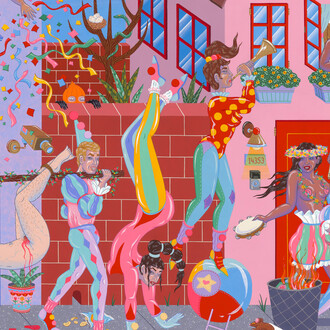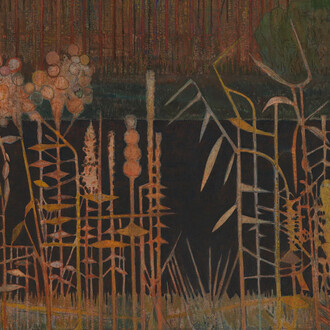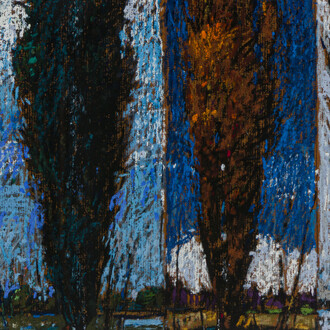The exhibition presents a series of paintings that I’ve been working on over the past year.
The images depict a vision of a deserted island inhabited by beings that partially resemble humans in ordinary situations—taking photos at the seaside, taking a selfie with a horse during a night ride, or at a balcony during a party. These everyday scenes are created by beings who are not entirely human, even though everything suggests otherwise. I like to explore the boundary between illusion and reality, and the process of shaping our perceptions through memory and the environment that influences our minds.
This exhibition, unlike my previous few, is not about deconstructing reality using movie sets, but about realities that resemble the future or a scientific experiment from the future.
Over the past four years I often mentioned the theme of the future in connection with my work. I should clarify that I do not aim to create a vision of the future as such, nor do I avoid utopian or dystopian visions. I am not explicitly focused on ecological or sociological forecasts either. Without discounting any of those ideas, my primary goal is to create a possibility of the future as a mental space—something that attempts to escape all predetermined scenarios of development. I see the future as an open space, with hope that life will continue in any form. There’s also room within my canvases to explore the boundary between what is imaginable and what is pre-ordained in the mental space. This connects to my previous work, which originated with visual schemas sourced from the past.
The characters often resemble influences from the Bauhaus movement, Oscar Schlemmer, and modernism in their stylization. However, they are engaged in a spatial play that convincingly appears quite realistic.
In terms of painting technique, the works are very dense and multi-layered, offering an experience both of the image itself and of the rich layers of textures, which I achieve through gradual layering of materials, such as glued paper or ash, with acrylic underpainting and oil paint for the final layers.
For the bricolage elements, I used archival printed materials from the 1960s and 70s. Those decades were not unlike the present, in which significant political changes were occurring in my country. The selection of pages often happens randomly, and I deliberately do not use them to influence the specific connection to the image. The fragments are further treated and overlaid with color, so what remains readable does so by chance. It is important to note that when viewed closely, the compositions create different realities than when viewed from a distance—there are two separate realities. Taken together, these fragments complete the thought process behind this exhibition: knowledge and understanding are pieced together on top of the skeletons of our past.
(Text by Daniel Pitín, 2025)
















